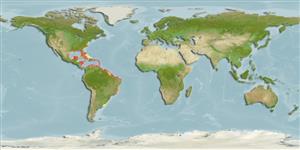>
Clupeiformes (Herrings) >
Dorosomatidae (Gizzard shads and sardinellas)
Etymology: Harengula: Old English haring, hering = mackerel, the fish Clupea harengus (Ref. 45335).
More on author: Poey.
Environment: milieu / climate zone / depth range / distribution range
Ecología
marino; salobre asociado a arrecife; rango de profundidad ? - 22 m (Ref. 26912), usually 1 - 5 m (Ref. 40849). Tropical; 43°N - 37°S, 99°W - 33°W (Ref. 188)
Western Atlantic: New Jersey, USA and Bermuda southward to Florida (USA), Gulf of Mexico, Caribbean, and southern Brazil. Often confused with Harengula clupeola with which it co-occurs over most of its range.
Length at first maturity / Tamaño / Peso / Age
Maturity: Lm 8.1, range 8 - 8.5 cm
Max length : 21.2 cm TL macho / no sexado; (Ref. 5217); common length : 12.0 cm SL macho / no sexado; (Ref. 188); edad máxima reportada: 3.00 años (Ref. 12193)
Espinas dorsales (total): 0; Radios blandos dorsales (total): 13-21; Espinas anales 0; Radios blandos anales: 12 - 23. Tooth plate on tongue and tooth plate behind it (basihyal and basibranchial tooth plates) very broad, their width about 3 to 5 times in their combined length, the basihyal tooth plate with a very distinct bulge in front (Ref. 188). Scales fairly strongly attached, not easily lost (Ref. 188). No dark pigment on dorsal fin tip (Ref. 188). No orange or red spot at opercle. Belly deep, lower profile decidedly more curved than the flattened upper profile (Ref. 7251).
Occurs in coastal waters, over mud sand bottoms and frequently near brackish or hyper-saline estuaries (Ref. 5217). Forms schools. Marketed fresh or canned.
Juveniles of 2.9 to 4.4 cm SL appeared in Guanabara Bay, Rio de Janeiro, in May and migrated out in December or March at 7.5 to 8.0 cm.
Whitehead, P.J.P., 1985. FAO Species Catalogue. Vol. 7. Clupeoid fishes of the world (suborder Clupeoidei). An annotated and illustrated catalogue of the herrings, sardines, pilchards, sprats, shads, anchovies and wolf-herrings. FAO Fish. Synop. 125(7/1):1-303. Rome: FAO. (Ref. 188)
IUCN Red List Status (Ref. 130435)
Threat to humans
Harmless
Human uses
Pesquerías: escaso valor comercial
Más información
ReferenciasAcuiculturaPerfil de acuiculturaRazasGenéticaElectrophoresesheritabilidadEnfermedadesProcesamientoNutrientsMass conversion
ColaboradoresImágenesStamps, Coins Misc.SonidosCiguateraVelocidadTipo de nataciónSuperficie branquialOtolitosCerebrosVisión
Herramientas
Special reports
Download XML
Fuentes de Internet
Estimates based on models
Preferred temperature (Ref.
123201): 23.2 - 28.1, mean 27.1 °C (based on 872 cells).
Phylogenetic diversity index (Ref.
82804): PD
50 = 0.5625 [Uniqueness, from 0.5 = low to 2.0 = high].
Bayesian length-weight: a=0.00912 (0.00784 - 0.01061), b=3.05 (3.01 - 3.09), in cm total length, based on LWR estimates for this species (Ref.
93245).
Nivel trófico (Ref.
69278): 3.4 ±0.0 se; based on diet studies.
Resiliencia (Ref.
120179): Medio, población duplicada en un tiempo mínimo de 1.4-4.4 años (K=0.48-0.60; tmax=3; Fec=5,000).
Fishing Vulnerability (Ref.
59153): Low vulnerability (21 of 100).
Nutrients (Ref.
124155): Calcium = 86.2 [44.5, 151.8] mg/100g; Iron = 0.898 [0.473, 1.548] mg/100g; Protein = 19.5 [18.2, 20.7] %; Omega3 = 0.231 [0.131, 0.402] g/100g; Selenium = 25.5 [13.4, 49.8] μg/100g; VitaminA = 123 [40, 348] μg/100g; Zinc = 1.56 [1.06, 2.25] mg/100g (wet weight);
